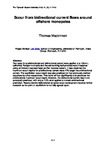Scour from bidirectional current flows around offshore monopoles
| dc.contributor.author | Mackinnon, T. | |
| dc.date.accessioned | 2019-05-22T09:23:41Z | |
| dc.date.available | 2019-05-22T09:23:41Z | |
| dc.date.issued | 2018 | |
| dc.identifier.citation |
Mackinnon, T. (2018) ' | en_US |
| dc.identifier.issn | 1754-2383 | |
| dc.identifier.uri | http://hdl.handle.net/10026.1/14189 | |
| dc.description.abstract |
Two tests for a unidirectional and bidirectional current were applied to a 100mm, cylindrical Perspex monopile and the surrounding bathymetries were measured using an industry standard laser profiler traverse system. It was observed the maximum scour depths for a bidirectional current were 47% larger the unidirectional current. The equilibrium scour depth was also predicted by four previously derived equations by other researchers. This found all four significantly over predicted the unidirectional maximum scour depth; however, the bidirectional current was more accurately predicted, with only a 1.5% error against a modern unidirectional prediction. Results identify bidirectional temporal scour development requires further research as the point of equilibrium is not fully agreed upon. | en_US |
| dc.language.iso | en | en_US |
| dc.publisher | University of Plymouth | |
| dc.rights | Attribution 3.0 United States | * |
| dc.rights.uri | http://creativecommons.org/licenses/by/3.0/us/ | * |
| dc.subject | current flows | en_US |
| dc.subject | offshore | en_US |
| dc.subject | monopoles | en_US |
| dc.subject | cylindrical Perspex monopile | en_US |
| dc.subject | unidirectional current | en_US |
| dc.subject | bidirectional current | en_US |
| dc.subject | scour | en_US |
| dc.title | Scour from bidirectional current flows around offshore monopoles | en_US |
| dc.type | Article | |
| plymouth.issue | 2 | |
| plymouth.volume | 11 | |
| plymouth.journal | The Plymouth Student Scientist |



